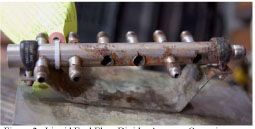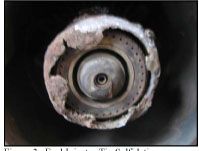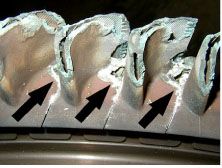Gas turbine corrosion mechanisms
Gas turbine corrosion is a common phenomenon experienced by operators. It can be traced to contaminants through the air inlet system, water systems (from evaporative cooler carryover, compressor wash solutions, NOx control injection water, and dual fuel injector purging), and fuel (gaseous and liquid).
Below are excerpts from a paper "Gas turbine durability in harsher environments" by Zaher Mutasim of Solar Turbines Incorporated at the first Middle East Turbomachinery Symposium held in Qatar.
Ingested contaminants can result in corrosion to the compressor, combustion, and turbine sections of gas turbine engines if proper product design and mitigation solutions are not applied. In most applications, corrosion of compressor components is unlikely during engine operation because the compressor is dry. However, during shutdowns where cold surfaces condense water, chemical species such as hydrochloric acid and sulfur trioxide can be absorbed in the water producing an acidic, corrosive liquid. This liquid phase can result in aqueous corrosion of compressor components through a variety of mechanisms, e.g., generalized, pitting, and crevice corrosion, and stress corrosion cracking. In cases where hydrochloric acid and sulfur trioxide are present and the relative humidity is high, the high velocity of the air at the compressor inlet causes the temperature of the air to drop due to conversion of internal energy to kinetic energy. The temperature drop can result in the formation of a liquid phase in the forward stages of the compressor during operation.

Liquid Fuel Flow Divider Aqueous Corrosion[/caption]
Corrosion in some instances has resulted in the binding of variable stator vanes and subsequent high cycle fatigue failure of compressor airfoils. Combustion Section Two main types of corrosion are known to affect components within the combustion section. Aqueous / acidic corrosion of fuel delivery system components such as fuel manifolds and fuel flow dividers, and fuel injector braze joints can occur in much the same way as the aqueous corrosion of compressor components, except that the contaminants can also be fuel borne. Corrosion to these components can result in fuel leaks and fires, and malfunction of fuel injectors.

Fuel Injector Tip Sulfidation[/caption]
Sulfidation, which is the reaction between a metal and a sulfur/oxygen-containing atmosphere to form sulfides and/or oxides, can affect fuel injector tips. In essence, sulfidation attack is a form of accelerated oxidation resulting in rapid degradation of the substrate material due to loss of corrosion protection. Whereas during oxidation protective oxide scales can form, the metallic sulfides formed are not protective. This accounts for the rapid rate of degradation produced by sulfidation attack.

Type I Hot Corrosion Attack to Turbine Blade
Airfoils and Tips[/caption]
Turbine section hot corrosion is the most serious form of corrosion experienced by the turbine section components. To better understand hot corrosion, it is useful to first discuss oxidation. Oxidation is the chemical reaction at high temperatures between a component and the oxygen in its surrounding gaseous environment. Oxidation of turbine section components is relatively easy to predict and measures can be taken to control it since it primarily involves relatively simple metal/oxygen reactions. The oxidation rate increases with temperature. Metal loss due to oxidation can be reduced by the formation of protective oxide scales. Chromium, aluminum, and silicon are the only chemical elements known to form protective oxide scales at the temperatures encountered in gas turbine engine hot sections. The presence of these elements in turbine engine alloys and coatings results in improved oxidation resistance.

Type II Hot Corrosion Attack to Turbine Blade Shank[/caption]
Hot corrosion is a form of accelerated oxidation that is produced by the chemical reaction between a component and molten salts deposited on its surface. Hot corrosion comprises a complex series of chemical reactions, making corrosion rates very difficult to predict. Sodium sulfate is usually the primary component of the deposit and degradation becomes more severe with increasing concentration levels of contaminants such as sodium, potassium, vanadium, sulfur, chlorine, fluorine, and lead. The rate and mechanism of hot corrosion attack is influenced by temperature.
There are two types of hot corrosion. Type I or high temperature hot corrosion, occurs at a temperature range of 730 to 950°C. Type II or low temperature hot corrosion occurs at a temperature range of 550 to 730°C. These types of hot corrosion attack feature distinct mechanisms and exhibit unique features. Both types can occur in the turbine section. Because of the varying service temperatures experienced by turbine section components, both corrosion types can occur on the same component. For example, Type I hot corrosion may occur on first and second stage turbine blade airfoils and tips, whereas Type II hot corrosion may occur under the platform of first and second stage turbine blades.
To achieve higher power density, gas turbines must run at higher firing temperatures. This can be achieved with advanced alloys that can withstand the higher operating temperatures. To achieve the alloy’s desired high temperature mechanical properties, alloy compositions must be altered. For example, refractory elements are added to alloys to increase their mechanical strength, but at the expense of other elements such as chromium, which is essential for hot corrosion resistance.